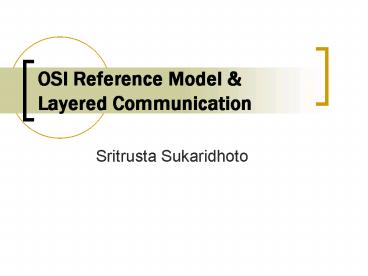OSI Reference Model - PowerPoint PPT Presentation
1 / 48
Title:
OSI Reference Model
Description:
Netbios Names. AppleTalk. ASP. SCP. DECnet. Transport. Layer 4. Function ... Flow control is the process of controlling the rate at witch a computer sends data. ... – PowerPoint PPT presentation
Number of Views:109
Avg rating:3.0/5.0
Title: OSI Reference Model
1
OSI Reference Model Layered Communication
- Sritrusta Sukaridhoto
2
OSI Layer
- Open Systems Interconnection for Communications
- There are 7 Layers
- Layers 7,6,5 are oriented more toward services to
the applications - Layer 4,3,2,1 are oriented more toward the flows
data from end-to-end through network
3
7 Layer OSI
4
How to Remember (CISCO)
- Please ? Physical
- Do ? Data Link
- Not ? Network
- Throw ? Transport
- Sousces ? Session
- Pizza ? Presentation
- Away ? Application
5
Application
- Layer 7
6
Function Description
- An application that communicates with other
computers is implementing OSI application layer
concepts. Application layer refer to
communications service to application.
7
Example
- Telnet
- HTTP
- FTP
- WWW Browser
- NFS
- SMTP Gateway
- SNMP
8
Presentation
- Layer 6
9
Function Description
- This layer main purpose is defining data format
such as ASCII text, EBCDIC text, binary, BCD,
JPEG. - Encryption is also defined by OSI as presentation
layer service.
10
Example
- JPEG
- ASCII
- TIFF
- GIF
- PICT
- MPEG
- MIDI
- Encryption
11
Session
- Layer 5
12
Function Description
- This session layer defines how to start, control,
and end conversation (called session). - This includes the control and management of multi
bidirectional messages so that application can be
notified if only some of a series of messages are
completed.
13
Example
- RPC
- SQL
- NFS
- Netbios Names
- AppleTalk
- ASP
- SCP
- DECnet
14
Transport
- Layer 4
15
Function Description
- Layer 4 includes the choice of protocols that
either do or do not provide error recovery.
Multiplexing of incoming data for different flows
to applications on the same host.
16
Example
- TCP
- UDP
- SPX
17
Network
- Layer 3
18
Function Description
- This layer defines end-to-end delivery packets.
To accomplish this, the network layer defines
logical addressing so that any endpoint can be
identified. It also defines how routing works and
how routes are learned so that the packets can be
delivered - Network layer also defines how to fragment a
packet into smaller packets to accommodate media
with smaller maximum transmission unit size
19
Example
- IP
- IPX
- AppleTalk DDP
20
Data Link
- Layer 2
21
Function Description
- The data link specifications are concerned with
getting data across one particular link or
medium. The data link protocols define delivery
across an individual link. These protocols are
necessary concerned with the type of media in
question.
22
Example
- IEEE 802.3/802.2
- HDLC
- Frame Relay
- PPP
- FDDI
- ATM
23
Physical
- Layer 1
24
Function Description
- Deal with the physical characteristics of the
transmission medium, Connection pins, use of
pins, electrical currents, encoding and light
modulation.
25
Example
- Ethernet
- RJ-45
- V.35
- FDDI
- EIA/TIA-232
26
- Some protocol define details of multiple layers.
- Example NFS
27
Benefit Concept
- Humans can discuss and learn about many details
of a protocol specification easier - Standardized interfaces among layers
- Better environment for interoperability
- Reduce complexity, faster production
- Each layer can define header and trailers around
the user data - One layer use the services of the layer
immediately below it.
28
Interaction Between OSI Layer
29
On Same Computer
30
- Step 1 Physical Layer, ensure bit
synchronization - Step 2 Data Link Layer, Frame Check Sequence
(FCS) whether error occurred in transmission - Step 3 Network Layer, Exam address
- Step 4 Transport Layer, acknowleadment
- Step 5 Session Layer, to ensure that a series
of messages is completed - Step 6 Presentation Layer, manipulate data
format - Step 7 Application Layer, processes the final
header and then can examine the true end-user data
31
Different Computer
32
Data Encapsulation
33
5 Step Data Encapsulation
- Create the data
- Package the data for transport
- Add the destination network layer address to the
data - Add the destination data link address to the data
- Transmit the bit
34
Frames, Packets and Seqments
35
- The layer 2 PDU (Protocol Data Unit) including
the data link header and trailer Frame - The Layer 3 PDU packet
- The Layer 4 PDU seqment
36
OSI, TCP/IP
37
OSI Transport Layer Function
- Connection Oriented vs Connectionless Oriented
38
Error Recovery
39
(No Transcript)
40
(No Transcript)
41
Flow Control
- Flow control is the process of controlling the
rate at witch a computer sends data. - Implementation
- Buffering
- Congestion Avoidance
- Windowing
42
Buffering
- Buffering simply means that computers reserve
enough buffer space that bursts of incoming data
can be held until processed
43
Congestion Avoidance
44
Windowing
45
Data Link Function
- MAC Media Access Control
- CSMA/CD Carrier Sense Multiple Access/Collision
Detect
46
OSI Network Layer Function
- Routing
- Sending data to a nearby Router
- Routing data Across Network
- Delivering Data to End Destination
- Addressing
47
(No Transcript)
48
Summary
- Application (Layer 7) ? User Interface ? Telnet,
HTTP - Application (Layer 6) ? How data is presented ?
JPEG, ASCII - Session (Layer 5) ? Keeping data separate from
different application ? OS, application access
scheduling - Transport (Layer 4) ? Reliable or unreliable
delivery, Multiplexing ? TCP, UDP, SPX - Network (Layer 3) ? Logical addressing, Routing ?
IP, IPX - Data Link (Layer 2) ? MAC, error detection ?
802.3/802.2, HDLC - Physical (Layer 1) ? Devices ? Ethernet, V.35































